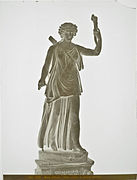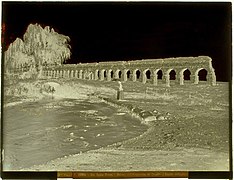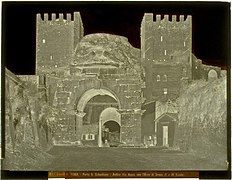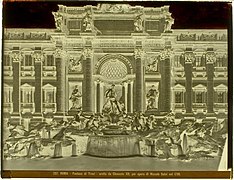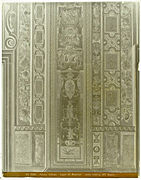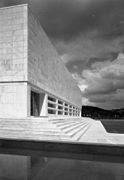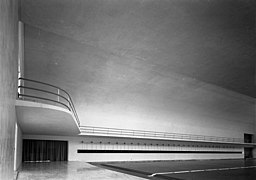Studio fotografico Vasari
Studio fotografico Vasari it is one of the oldest Italian companies operating in the field of photography.
The studio is known for its specialization in
Collections of Vasari photographs are held by the

History

The company founder Cesare Vasari (
After Cesare moved to
Initially, the laboratory for the development and printing of the photographs was located in via della Mercede, subsequently transferred to via Ludovisi and finally to
Tommaso, who had two children (Laura and Giorgio), was succeeded by Giorgio, a doctor in chemistry (Rome, 11 September 1931 - Filettino, 3 July 2004). Under Giorgio, the business developed in the fields of art, architecture and
Subsequently, Giorgio's sons (Alessandro, Andrea and Francesco) continued the studio's activity, establishing the Vasari Photographic Archive and enriching it through photographic campaigns commissioned by state bodies,
Today the company is directed by Alessandro Vasari (Rome, 25 February 1957).[4][5]
Vasari and the architecture
The specialization in architectural photography began at first under Cesare Vasari, but Tommaso and Giorgio added a strong impulse to this kind of shooting with their work for important architects such as Enrico Del Debbio,[6] Pier Luigi Nervi, Luigi Walter Moretti and Giuseppe Vaccaro[7]
The photographic archive
The historical archive of Vasari which contains 5,024 plate (in glass 21x27 cm and other 13x18 cm). It is currently available at the Chalcography-Istituto Nazionale per la Grafica.
The third party production from 1910 ca. to immediately postwar period, consisting of 350,000 black and white and color plates and negatives, is kept in the Study and Communication Archive Center (CSAC) of the University of Parma.
The Vasari private archive (about 90,000 films of various positive, negative black/white and color formats and high resolution digital files). This constantly expanding fund includes the photographic production of the Vasari to date and can be consulted on a research database by subject, author and location via the website of the photographic studio.
Exhibitions on Vasari photographers
- Rome 1991: The Vasari: a dynasty of photographers in Rome from 1875 to 1991, 26 February - 30 April, Biblioteca Vallicelliana of Oratorio dei Filippini[8]
- Ximenes atelier, curated by Paolo Barbaro, texts by Marzio Pieri, CSAC of University of Parma.
- Milan 2010: Walk the Stones - a journey through time and the streets of Rome, Spazio ILEX of Archivolto - Milan, 14–30 April
- Stockholm 16 October - 6 November 2014: At the origins of the European Union. Italian architecture and art for the Palazzo della Farnesina, Istituto Italiano di Cultura[9]
- Berlin 12 November - 4 December 2014: At the origins of the European Union. Italian architecture and art for the Palazzo della Farnesina, Italian Embassy
- Skopje 11 December 2014 - 21 January 2015: At the origins of the European Union. Italian architecture and art for the Palazzo della Farnesina, Macedonian National Gallery "Chifte Hamam"
Gallery
-
Negative on glass plate, depicting Diana Lancifera, Vatican Museums
-
View of Villa Algardi invilla Doria Pamphilj
-
Negative on glass plate, view of Claudio's aqueduct,Via Appia
-
Negative on glass plate, view ofArco di Druso, Via Appia
-
Negative on glass plate, view of the Trevi Fountain work by Niccolò Salvi 1730
-
Negative on glass plate, view of the Sala Regia, Vatican Apostolic Palaces
-
Negative on glass plate, view of the Loggia del Mantovani, Vatican Apostolic Palaces
-
Vasari for the architect Moretti, Fencing Academy at the Foro Italico, Rome
-
Vasari for the architect Moretti, Foro Italico, Rome
-
Vasari for the architect Moretti, Panorama of Foro Italico, Rome
See also
- Istituto Nazionale per la Grafica
- Centro studi e archivio della comunicazione
- George Eastman House
- Tommaso Cuccioni
References
- ^ "Scheda su Foto Vasari". Retrieved 26 June 2018.
- ^ "Eastman Museum - Vasari". Retrieved 23 October 2016.
- ^ "The Vasari in a page dedicated to Enrico Del Debbio, with whom they collaborated with 800 b/w photos of the Foro Italico" (PDF). 16 October 2014. Archived from the original (PDF) on 4 March 2016. Retrieved 23 May 2020.
- ^ "Alessandro Vasari". Retrieved 6 May 2020.
- ^ "Destino d'arte". Retrieved 6 May 2020.
- ^ "Archivio Enrico Del Debbio". Archived from the original on 20 October 2014. Retrieved 12 October 2014.
- ^ "Studio Fotografico Vasari per l'architetto Giuseppe Vaccaro". Retrieved 3 May 2020.
- ^ "I Vasari". Retrieved 4 May 2020.
- ^ "Alle origini dell'Unione Europea. Architettura e arte italiana per il Palazzo della Farnesina". Retrieved 6 May 2020.
Further reading
- Alberto Manodori, Alessandro Vasari, Roma mai più Roma: attraverso le fotografie di Alessandro Vasari, Edizioni Golden Series, 1983
- Marina Miraglia, Cesare Vasari e il "genere" nella fotografia napoletana dell'Ottocento, in Bollettino d'Arte, serie VI, 33–34, pp. 199–296
- Biblioteca Vallicelliana, I Vasari: una dinastia di fotografi a Roma dal 1875 al 1991, a cura della Biblioteca Vallicelliana, catalogo della mostra, Roma 1991
- Paolo Barbaro, testi di Marzio Pieri, Il *gesso e la creta: studio Vasari Roma, l'atelier Ximenes, catalogo della mostra, CSAC dell'Università, Parma 1994, codice SBN BVE0084839
- Anita Margiotta e M. Grazia Massafra, Un percorso fotografico a palazzo Braschi (1870-1987). Catalogo della mostra (anche e-book), pag. 129, Gangemi Editore, Roma 2012, ISBN 978-88-492-5253-8 [1]
- Roberta Tucci, I suoni della campagna romana. Per una ricostruzione del paesaggio sonoro di un territorio del Lazio., con CD Audio, pag. 206, Rubettino Editore, Soveria Mannelli 2003, ISBN 978-88-498-0614-4 [2]
- Francesca Recine, La documentazione fotografica dell'arte in Italia dagli albori all'epoca moderna, pp. 49 e 50, Edizioni Scriptaweb, Napoli 2006 [3]
- Francesco Buranelli, Laocoonte: alle origini dei Musei Vaticani, pag. 80 e 136, Edizioni L'Erma di Bretschneider, Roma 2006, ISBN 978-88-8265-409-2 [4]
- Marina Miraglia,Fotografi e pittori alla prova della modernità, Bruno Mondadori Editore, Milano 2012, ISBN 978-88-6159-657-3
External links
- Website of the Photographic Archive
- Since 2023, the Istituto Centrale per la Grafica in Roma has put online 998 glass plates by Alessandro Vasari (1866-1929), (in italian)
- Ministry of Cultural Heritage and Activities (Italy) - Central Institute for Catalog and Documentation
- I Vasari, exhibition catalog held at the Biblioteca Vallicelliana (in Italian).
- Photographs of the Vasari Studio fund at the National Institute for Graphics (in Italian)
- Fondo Vasari at the Ministry of Cultural Heritage and Activities (MIBACT)(in Italian)
- Il Fondo Vasari nel Catalogo del Sistema Museale dell'Università di Parma (in Italian)
- Francesca Recine pag. 49 e 50. I Vasari ne La documentazione fotografica dell'arte in italia dagli albori all'epoca moderna (in Italian).
{{cite book}}: CS1 maint: numeric names: authors list (link) - Vasari Images at the International Museum of Photography and Film in Rochester
- "Le Immagini dei Vasari alla Fondazione Dalmine di Bergamo" (in Italian). Archived from the original on 22 August 2013. Retrieved 16 January 2015.
- "La villa Maraini da nord-est con la zona d'ingresso, Vasari 1910, Istituto Svizzero di Roma" (in Italian). Archived from the original on 14 February 2015. Retrieved 1 February 2015.
- "Studio fotografico Vasari per l'architetto Giuseppe Vaccaro" (in Italian). Retrieved 3 May 2020.
- "Istituto Centrale per la Grafica - (MiBACT) – Collezioni fotografiche" (in Italian). Retrieved 6 May 2020.

